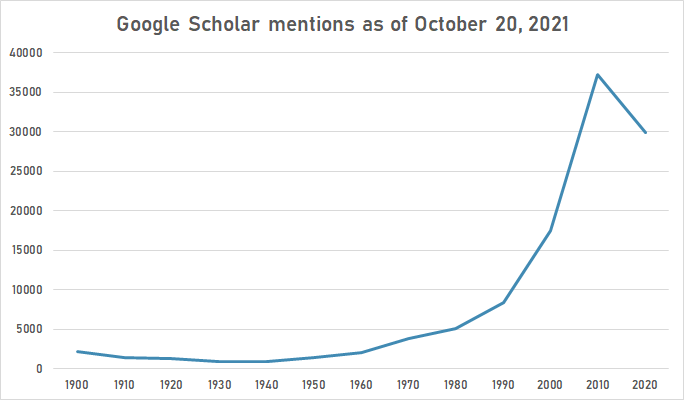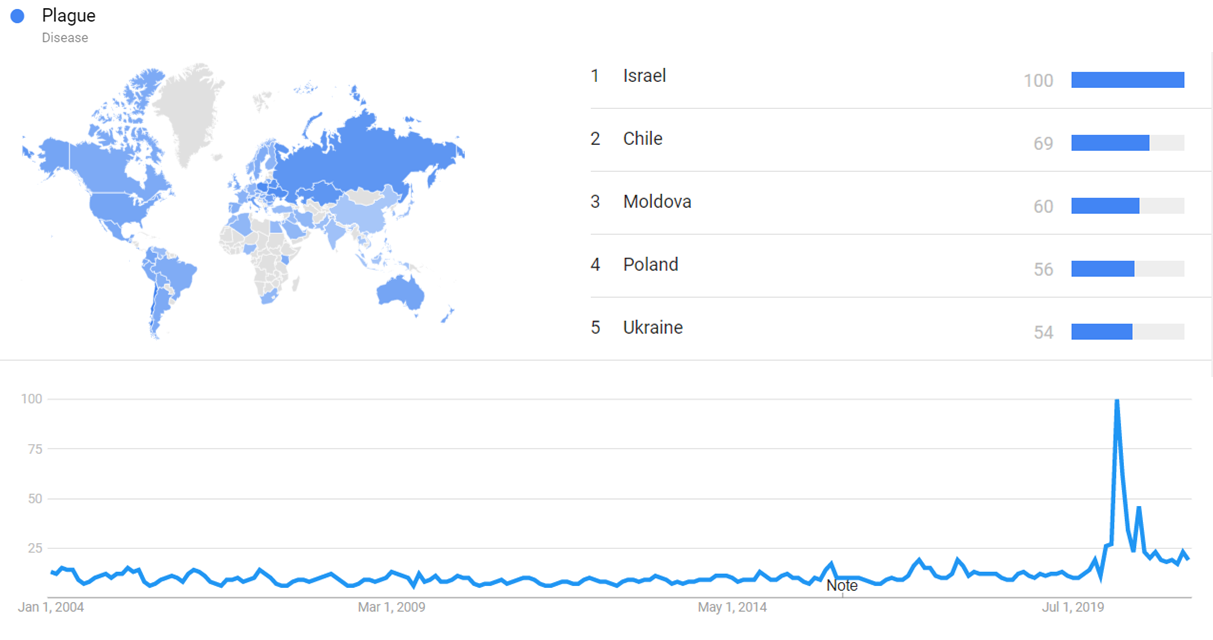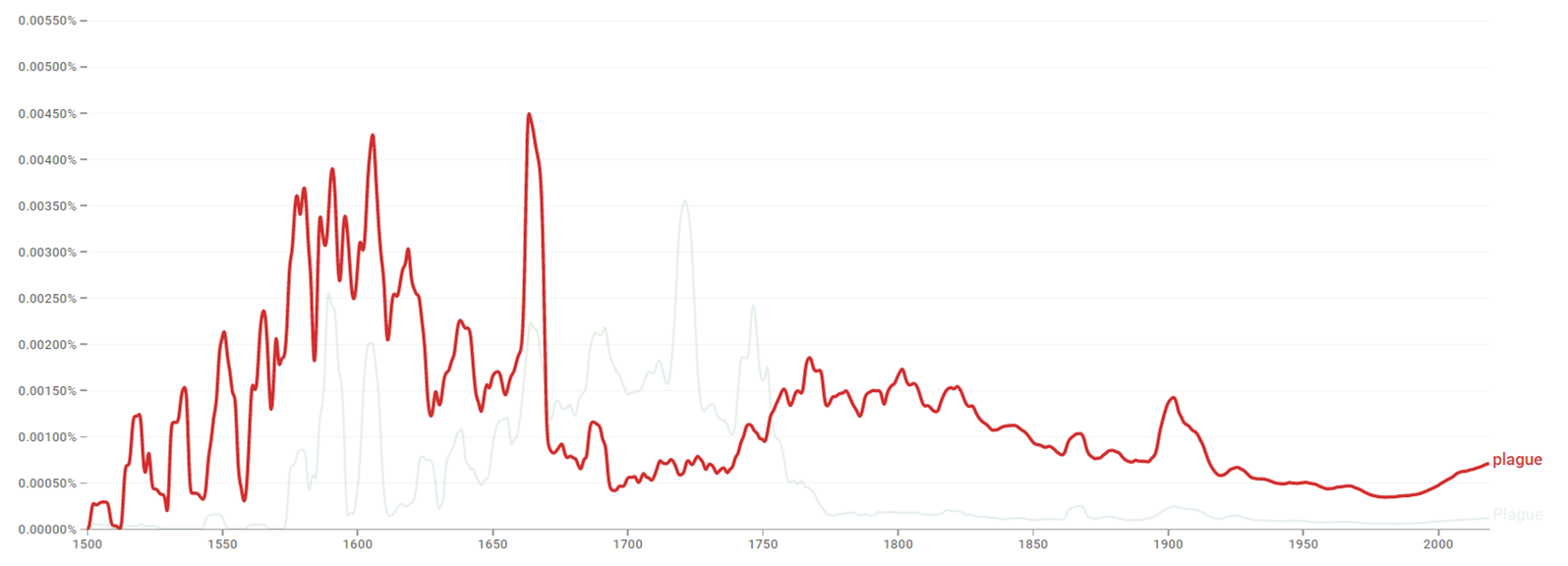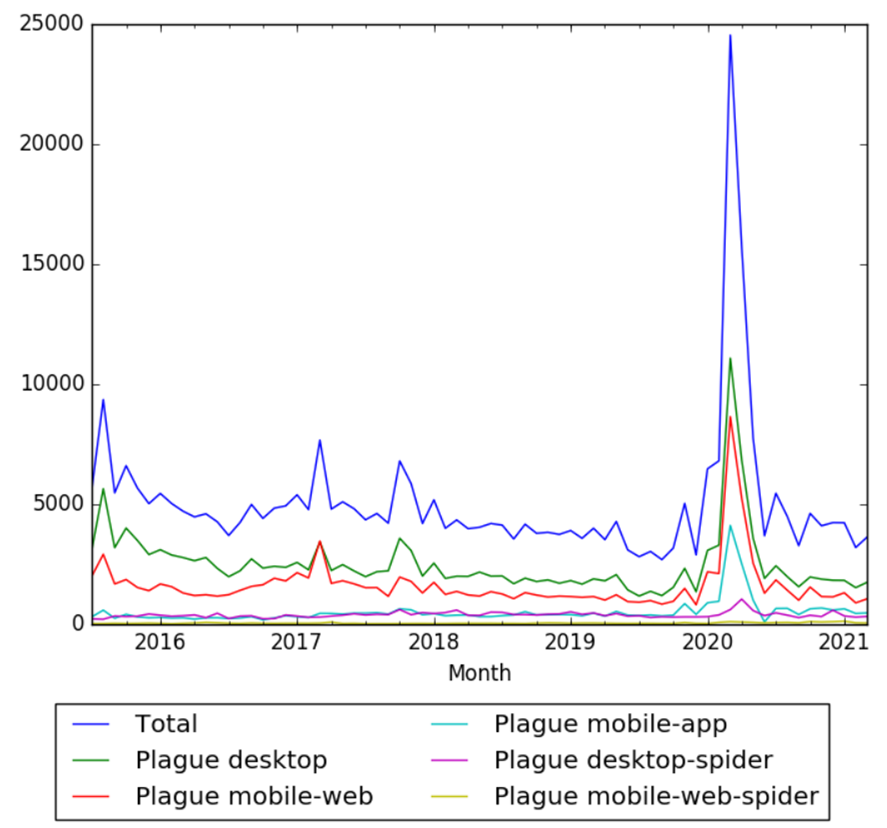Timeline of plague
This is a timeline of plague, describing major events such as epidemics and key medical developments.
Big picture
| Time period | Key developments |
|---|---|
| 541–750 (circa) | The first plague pandemic spreads from Egypt to the Mediterranean (starting with the Plague of Justinian) and Northwestern Europe.[1] |
| 1346–1840 | The second plague pandemic spreads from Central Asia to the Mediterranean and Europe.[1] The Black Death of 1346-53 is considered to be unparalleled in human history.[2] From 1347 to 1665, the Black Death is responsible for about 25 million deaths in Europe.[3] |
| 1866–1960s | The third plague pandemic, which originated in China, results in about 2.2 million deaths.[3] Haffkine develops the first vaccine against bubonic plague.[4] Antibiotic drugs are developed in the 1940s which dramatically reduce the death rate from plague.[5] |
| 1950–2000 | Plague cases are massively reduced during the second half of the 20th century. However, outbreaks would still occur, especially in developing countries. Between 1954 and 1997, human plague is reported in 38 countries, making the disease a reemerging threat to human health.[3] Also, between 1987 and 2001, 36,876 confirmed cases of plague with 2,847 deaths are reported to the World Health Organization.[6] |
| Recent years | Today, fewer than 200 people die of the plague worldwide each year, mainly due to lack of treatment.[7] Plague is considered to be endemic in 26 countries around the world, with most cases found in remote areas of Africa.[8] The 3 most endemic countries are Madagascar, the Democratic Republic of Congo and Peru.[9] |
=
Full timeline
| Year/Period | Event type | Event | Present-day geographic location |
|---|---|---|---|
| 224 BC | Plague infection is first recorded in China.[10] | People's Republic of China | |
| 430 BC | Epidemic | Plague of Athens devastates the city's population. The outbreak also affects much of the eastern Mediterranean region.[11] | Greece, Mediterranean basin |
| 262 AD | Epidemic | Plague breaks out in Rome. It is estimated to kill about 5000 people a day.[11] | Italy |
| 540 AD | Epidemic | Plague epidemic originates in Ethiopia spreads to Pelusium in Egypt.[12] | Ethiopia, Egypt |
| 541–542 AD | Epidemic | The Plague of Justinian breaks out and develops as an extended epidemic in the Mediterranean basin. Frequent outbreaks over the next two hundred years would eventually kill an estimated 25 million people. The Justinian Plague is considered the first recorded pandemic.[3][13] | Mediterranean Basin |
| 542 AD | Epidemic | The plague arrives in Constantinople (now Istanbul). By spring of 542, about 5,000 deaths per day in the city are calculated, although some estimates vary to 10,000 per day. The epidemic would go on to kill over a third of the city’s population.[12] | Turkey |
| 543 AD | Epidemic | After passing from Italy to Syria, Palestine, and Iraq, plague reaches what is now modern Iran.[6] | Iran |
| 627 AD | Epidemic | A large epidemic of plague breaks out in Ctesiphon, the capital of the Sasanian Empire, killing more than 100,000 people.[6] | Iran |
| 1334 | Epidemic | The second plague pandemic breaks out in China. Widely known as the "Black Death" or the Great Plague, it is regarded as one of the most devastating pandemics in human history, resulting in the deaths of an estimated 75 to 200 million people in Eurasia.[13] | Eurasia |
| 1345 | Plague occurs in southern Russia, around the lower Volga River basin.[14][15] | Russia | |
| 1338–1339 | Bubonic plague is reported in central Asia.[16] | ||
| 1346 | Epidemic | Bubonic plague breaks out in China and India.[16] | China, India |
| 1347 | Epidemic | The plague spreads to Constantinople, a major port city. It also infects the Black Sea port of Kaffa down from southern Russia.[15][16] | Turkey, Ukraine |
| 1347 | Epidemic | Italian traders bring the plague in rat-infested ships from Constantinople to Sicily, which becomes the first place in Europe to suffer the Black death epidemic. The same year, Venice is also hit.[7] | Italy |
| 1347–1350 | Medical development | During the 1347–1350 outbreak, doctors are completely unable to prevent or cure the plague. Some of the cures they try include cooked onions, ten-year-old treacle, arsenic, crushed emeralds, sitting in the sewers, sitting in a room between two enormous fires, fumigating the house with herbs, trying to stop God punishing the sick for their sin. Flagellants would go on processions whipping themselves.[17] | |
| 1348 | Medical development | Italian writer Giovanni Boccaccio in his book Decameron writes a description of symptoms of the plague.[12] | Italy |
| 1348–1350 | Epidemic | The Black Death arrives at Melcombe Regis in the south of England. Over the next year, the plague spreads into Wales, Ireland and Northern England. By 1350, the plague reaches Scotland. The estimated death toll for the British Isles and Ireland is calculated at 3.2 million.[18] | United Kingdom, Republic of Ireland |
| 1349 | Genocide | Black Death Jewish persecutions. A rumor rises claiming that Jews are responsible for the plague as an attempt to kill Christians and dominate the world. Supported by a widely distributed report of the trial of Jews who supposedly had poisoned wells in Switzerland, the rumor spreads quickly. As a result, a wave of pogroms against Jews breaks out. Christians start to attack Jews in their communities, burning their homes, and murder them with clubs and axes. In the Strasbourg massacre, it is estimated that people locked up and burned 900 Jews alive. Finally, Pope Clement VI issues a religious order to stop the violence against the Jews, claiming that the plague is “the result of an angry God striking at the Christian people for their sins.”[7] | France, Switzerland |
| 1351 | Epidemic | Black Death epidemic reaches Russia, attacking Novgorod and reaching Pskov, before being temporarily suppressed by the Russian winter.[2] | Russia |
| 1352 | Epidemic | The plague reaches Moscow, only a few hundred miles from Caffa, the first city struck by the epidemic. Thus, the Black Death completes a great circle, killing from one-third to one-half of medieval Europe’s total population.[7] | Russia |
| 1361–1364 | Medical development | During an outbreak, doctors learn how to help the patient recover by bursting the buboes.[17] | |
| 1374 | Epidemic | Black Death epidemic re-emerges in Europe. In Venice, various public health controls such as isolating victims from healthy people and preventing ships with disease from landing at port are instituted.[12] | |
| 1377 | Program launch | The Republic of Ragusa establishes a landing station for vessels far from the city and harbour in which travellers suspected to have the plague must spend thirty days, to see whether they became ill and died or whether they remained healthy and could leave.[12] | Croatia |
| 1403 | After finding thirty days isolation to be too short, Venice dictates that travellers from the Levant in the eastern Mediterranean be isolated in a hospital for forty days, the quarantena or quaranta giorni, from which the term quarantine is derived.[12] | Italy | |
| 1629–1631 | Epidemic | The Italian plague of 1629–1631 develops as a series of outbreaks of bubonic plague. About 280,000 people are estimated to be killed in Lombardy and other territories of northern Italy.[19] The Italian plague is estimated to have claimed between 35 and 69 percent of the local population.[10] | Italy |
| 1637 | Epidemic | Plague breaks out in Andalusia, killing about 20,000 people in less than four months.[20] | Spain |
| 1647–1652 | Epidemic | Plague ravages Spain. About 30,000 die in Valencia. The great Plague of Seville breaks out.[20] | Spain |
| 1665–1666 | Epidemic | Great Plague of London. 100,000 people are killed within 18 months.[21] | United Kingdom |
| 1679 | Epidemic | The Great Plague of Vienna kills at least 76,000 people.[22] | Austria |
| 1722 | Publication | Daniel Defoe publishes A Journal of the Plague Year, a fictional account of the Great Plague of London in 1665. This novel is often read as non-fiction.[23] | United Kingdom |
| 1738 | Epidemic | Great Plague of 1738 kills at least 36,000 people.[24] | Romania, Hungary, Ukraine, Serbia, Croatia, Austria |
| 1772–1850 | Epidemic | The human plague is reported intermittently in the Chinese province of Yunnan, where the third plague pandemic would begin in the 1860s.[3][25] | People's Republic of China |
| 1867 | Epidemic | The plague spreads from Yunnan Province to Beihai on the Chinese coastline.[3] | People's Republic of China |
| 1869 | Epidemic | The plague is observed in Taiwan.[3] | Taiwan |
| 1894 | Epidemic | The plague spreads to Guangzhou Province and results in the death of about 70,000 people.[3] | People's Republic of China |
| 1894 | Scientific development | Working independently, both French bacteriologist Alexandre Yersin and Japanese bacteriologist Shibasaburo Kitasato isolate the bacterium that causes bubonic plague. Yersin discovers that rodents are the mode of infection. The bacterium is named yersinia pestis after Yersin.[3][12] | |
| 1896–1897 | Medical development | Russian bacteriologist Waldemar Haffkine successfully protects rabbits against an inoculation of virulent plague microbes, by treating them previously with a subcutaneous injection of a culture of the microbes in broth. The first vaccine for bubonic plague is developed. The rabbits treated in this way become immune to plague. In the next year, Haffkine causes himself to be inoculated with a similar preparation, thus proving in his own person the harmlessness of the fluid. This is considered the first vaccine against bubonic plague.[4] | India (Bombay) |
| 1899 | Epidemic | Plague is first introduced in Latin America in Paraguay, followed by Brazil and Argentina in the same year.[8] | Paraguay, Brazil, Argentina |
| 1901 | Epidemic | Plague infection is first reported in Uruguay.[8] | Uruguay |
| 1902 | Epidemic | Plague infection is first reported in Mexico.[8] | Mexico |
| 1903 | Epidemic | Plague infection is first reported in Chile and Peru.[8] | Chile, Peru |
| 1905 | Epidemic | Plague infection is first reported in Panama.[8] | Panama |
| 1908 | Epidemic | Plague infection is first reported in Ecuador and Venezuela.[8] | Ecuador, Venezuela |
| 1910 | Epidemic | Pneumonic plague breaks out in Manchuria, killing about 60,000 people over the course of a year.[26] | People's Republic of China |
| 1912 | Epidemic | Plague infection is first reported in Cuba and Puerto Rico.[8] | Cuba, Puerto Rico |
| 1921 | Epidemic | Plague infection is first reported in Bolivia.[8] | Bolivia |
| 1924–1925 | Epidemic | Plague breaks out in Los Angeles. 32 people get infected and only 2 survive. It is the last rat-borne epidemic occurring in the United States.[27] | United States |
| 1947 | Publication | French novelist Albert Camus publishes The Plague, a novel about a fictional outbreak of plague in Oran, Algeria. The book helps to show the effects the plague has on a populace.[28] | France |
| 1994 | Epidemic | Plague in India. The country experiences a large outbreak of pneumonic plague after 30 years with no reports of the disease. 693 suspected bubonic or pneumonic plague cases are reported.[6][29] | India |
| 2003 | Epidemic | An outbreak of plague is reported in Algeria, in an area considered plague-free for 50 years.[6] | Algeria |
| 2006 | Epidemic | 100 cases of suspected pneumonic plague, including 19 deaths, are reported in Orientale Province, Congo.[30] | Democratic Republic of the Congo |
| 2006 | Epidemic | 13 cases, with 2 deaths, are reported in the states of New Mexico, Colorado, California, and Texas.[31] | United States |
| 2009 | Infection | Plague is reported in Libya, after 25 years without a case of the disease.[6] | Libya |
| 2013 | Infection | A case of bubonic plague is reported in a region of Kyrgyzstan bordering Kazakhstan.[6] | Kyrgyzstan |
| 2013 | Infection | 783 cases of plague are reported worldwide in 2013, including 126 deaths.[6][9] | |
| 2014 | Scientific development | Researchers at Duke University School of Medicine and Duke-NUS Medical School Singapore find the yersinia pestis bacteria to hitchhike on immune cells in the lymph nodes and eventually ride into the lungs and the blood stream, thus spreading bubonic plague effectively to others.[32] | United States, Singapore |
| 2017 | Epidemic | 2017 Madagascar plague outbreak. From the 1 August through 22 November, a total of 2348 confirmed, probable and suspected cases of plague, including 202 deaths (case fatality rate 8.6 %).[33] | Madagascar |
Numerical and visual data =
Google Scholar
The following table summarizes per-year mentions on Google Scholar as of October 20, 2021.
| Year | plague |
|---|---|
| 1900 | 2,150 |
| 1910 | 1,480 |
| 1920 | 1,280 |
| 1930 | 942 |
| 1940 | 940 |
| 1950 | 1,390 |
| 1960 | 2,000 |
| 1970 | 3,770 |
| 1980 | 5,050 |
| 1990 | 8,340 |
| 2000 | 17,500 |
| 2010 | 37,200 |
| 2020 | 29,900 |

Google Trends
The chart below shows Google Trends data for Plague (Disease), from January 2004 to April 2021, when the screenshot was taken. Interest is also ranked by country and displayed on world map.[34]

Google Ngram Viewer
The chart below shows Google Ngram Viewer data for Plague, from 1500 to 2019.[35]

Wikipedia Views
The chart below shows pageviews of the English Wikipedia article Plague, on desktop from December 2007, and on mobile-web, desktop-spider, mobile-web-spider and mobile app, from July 2015; to March 2021.[36]

Other
-
Cases of human plague for the period 1994–2003 in countries that reported at least 100 confirmed or suspected cases. Case-fatality rates in % are represented on the left vertical.[31]
-
Plague cases reported in Africa to the World Health Organization for the period 1954-1986. Cumulative.[37]
-
Plague cases reported in Americas to the World Health Organization for the period 1954-1986. Cumulative.[37]
-
Plague cases reported in Asia to the World Health Organizations for the period 1954-1986. Cumulative.[37]
-
Plague cases reported to the World Health Organization by continent. Cumulative.[37]
Meta information on the timeline
How the timeline was built
The initial version of the timeline was written by User:Sebastian.
Funding information for this timeline is available.
What the timeline is still missing
Timeline update strategy
See also
External links
References
- ↑ 1.0 1.1 Byrne, Joseph Patrick (2012). Encyclopedia of the Black Death. Santa Barbara (CA): ABC-CLIO. p. xxi. ISBN 9781598842531.
- ↑ 2.0 2.1 "The Black Death: The Greatest Catastrophe Ever". historytoday.com. Retrieved 16 January 2017.
- ↑ 3.0 3.1 3.2 3.3 3.4 3.5 3.6 3.7 3.8 Xu, Lei; Liu, Qiyong; Stige, Leif Chr.; Ben Ar, Tamara; Fang, Xiye; Chan, Kung-Sik; Wang, Shuchun; Stenseth, Nils Chr.; Zhang, Zhibin. "Nonlinear effect of climate on plague during the third pandemic in China". doi:10.1073/pnas.1019486108. PMC 3121851.
{{cite journal}}: Cite journal requires|journal=(help) - ↑ 4.0 4.1 Hawgood, Barbara J. "Waldemar Mordecai Haffkine, CIE (1860–1930): prophylactic vaccination against cholera and bubonic plague in British India" (PDF). jameslindlibrary.org. Retrieved 19 January 2017.
- ↑ "Achievements in Public Health, 1900-1999: Control of Infectious Diseases". cdc.gov. Retrieved 28 January 2017.
- ↑ 6.0 6.1 6.2 6.3 6.4 6.5 6.6 6.7 Shahraki, Abdolrazagh Hashemi; Carniel, Elizabeth; Mostafavi, Ehsan. "Plague in Iran: its history and current status". PMC 5037359.
{{cite journal}}: Cite journal requires|journal=(help) - ↑ 7.0 7.1 7.2 7.3 "The 'Black Death': A Catastrophe in Medieval Europe". Constitutional Rights Foundation. Retrieved 16 January 2017.
- ↑ 8.0 8.1 8.2 8.3 8.4 8.5 8.6 8.7 8.8 Schneider, Maria Cristina; Najera, Patricia; Aldighieri, Sylvain; Galan, Deise I.; Bertherat, Eric; Ruiz, Alfonso; Dumit, Elsy; Gabastou, Jean Marc; Espinal, Marcos A. "Where Does Human Plague Still Persist in Latin America?". doi:10.1371/journal.pntd.0002680. PMC 3916238.
{{cite journal}}: Cite journal requires|journal=(help)CS1 maint: unflagged free DOI (link) - ↑ 9.0 9.1 "Plague". WHO. Retrieved 17 January 2017.
- ↑ 10.0 10.1 "Epidemics of the Past". infoplease.com. Retrieved 19 January 2017.
- ↑ 11.0 11.1 KERCHEVAL, HOWARD. "'One of the big-league diseases of all time'". United Press International. Retrieved 18 January 2017.
- ↑ 12.0 12.1 12.2 12.3 12.4 12.5 12.6 Frith, John. "The History of Plague – Part 1. The Three Great Pandemics". Journal of Military and Veterans' Health. ISSN 1839-2733. Retrieved 16 January 2017.
- ↑ 13.0 13.1 "History". Centers for Disease Control and Prevention. Retrieved 11 January 2017.
- ↑ Mansbach,, Richard W.; Taylor, Kirsten L. Introduction to Global Politics. Retrieved 18 January 2017.
{{cite book}}: CS1 maint: extra punctuation (link) - ↑ 15.0 15.1 Schmid, Boris V.; Büntgen, Ulf; Easterday, W. Ryan; Ginzler, Christian; Walløe, Lars; Bramanti, Barbara; Stenseth, Nils Chr. "Climate-driven introduction of the Black Death and successive plague reintroductions into Europe". doi:10.1073/pnas.1412887112. PMC 4364181.
{{cite journal}}: Cite journal requires|journal=(help) - ↑ 16.0 16.1 16.2 "The Black Plague: The Least You Need to Know". web.cn.edu. Carson-Newman University. Retrieved 16 January 2017.
- ↑ 17.0 17.1 "The Black Death". BBC. Retrieved 17 January 2017.
- ↑ "Course of the Black Death". BBC. Retrieved 17 January 2017.
- ↑ Kohn, George C. Encyclopedia of Plague and Pestilence: From Ancient Times to the Present. Retrieved 18 January 2017.
- ↑ 20.0 20.1 Kohn, George C. Encyclopedia of Plague and Pestilence: From Ancient Times to the Present. Retrieved 19 January 2017.
- ↑ "The Great Plague of London, 1665". Contagion, Historical Views of Diseases and Epidemics. Harvard University. Retrieved 19 January 2017.
- ↑ Porter, Stephen. The Great Plague. Retrieved 19 January 2017.
- ↑ "A Journal of the Plague Year". Oxford University Press. Retrieved 19 January 2017.
- ↑ "Demographic Changes". oszk.hu. Retrieved 19 January 2017.
- ↑ Davis, Lee Allyn. Natural Disasters. Retrieved 18 January 2017.
- ↑ TEH, WU LIEN; CHUN, J. W. H.; POLLITZER., R. "CLINICAL OBSERVATIONS UPON THE MANCHURIAN PLAGUE EPIDEMIC, 1920-21" (PDF). Manchurian Plague Prevention Service, China. Retrieved 18 January 2017.
- ↑ KELLOGG, W. H. "The Plague Situation" (PDF). PMC 1559064. Retrieved 19 January 2017.
{{cite journal}}: Cite journal requires|journal=(help) - ↑ "Albert Camus' The Plague: a story for our, and all, times". The Guardian. Retrieved 19 January 2017.
- ↑ cdc.gov. "International Notes Update: Human Plague -- India, 1994". Retrieved 18 January 2017.
- ↑ "Plague in the Democratic Republic of the Congo". WHO. Retrieved 17 January 2017.
- ↑ 31.0 31.1 Butler, Thomas. "Plague into the 21st Century". Oxford Journals. doi:10.1086/604718. Retrieved 14 January 2017.
- ↑ "Researchers discover exactly how the bubonic plague spread so effectively - and say it could improve our handling of Ebola". Dailymail. Retrieved 18 January 2017.
- ↑ "Plague – Madagascar". who.int. Retrieved 7 April 2018.
- ↑ "Plague". Google Trends. Retrieved 11 April 2021.
- ↑ "Plague". books.google.com. Retrieved 11 April 2021.
- ↑ "Plague". wikipediaviews.org. Retrieved 11 April 2021.
- ↑ 37.0 37.1 37.2 37.3 "WHO Report on Global Surveillance of Epidemic-prone Infectious Disease" (PDF). WHO. Retrieved 27 January 2017.
![Cases of human plague for the period 1994–2003 in countries that reported at least 100 confirmed or suspected cases. Case-fatality rates in % are represented on the left vertical.[31]](/images/0/09/Cases_of_Human_Plague_in_1994%E2%80%932003_in_the_Countries_That_Reported_at_least_100_Confirmed_or_Suspected_Cases.png)
![Plague cases reported in Africa to the World Health Organization for the period 1954-1986. Cumulative.[37]](/images/7/7b/Plague_cases_reported_in_Africa_to_the_World_Health_Organization_for_the_period_1954-1986.png)
![Plague cases reported in Americas to the World Health Organization for the period 1954-1986. Cumulative.[37]](/images/c/cf/Plague_cases_reported_in_Americas_to_the_World_Health_Organization_for_the_period_1954-1986.png)
![Plague cases reported in Asia to the World Health Organizations for the period 1954-1986. Cumulative.[37]](/images/0/09/Plague_cases_reported_in_Asia_to_the_World_Health_Organizations_for_the_period_1954-1986.png)
![Plague cases reported to the World Health Organization by continent. Cumulative.[37]](/images/1/1a/Plague_cases_reported_to_the_World_Health_Organization_by_continent._Cumulative.png)